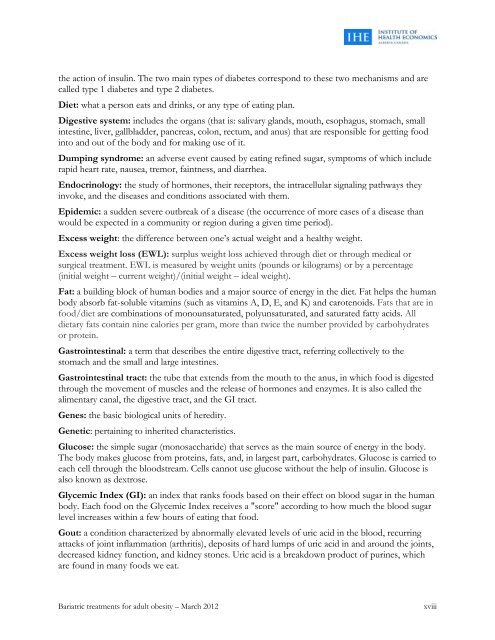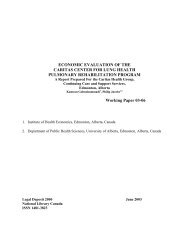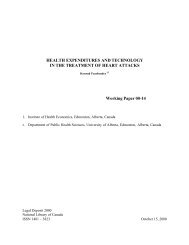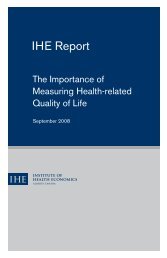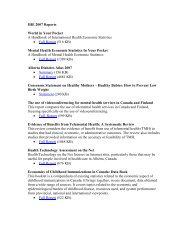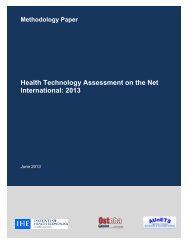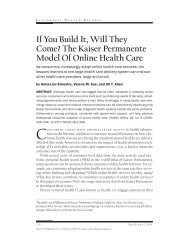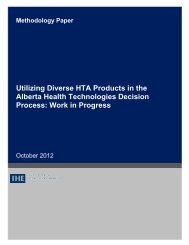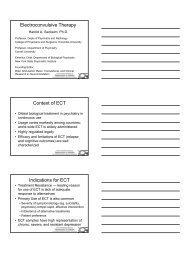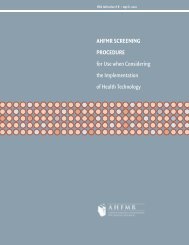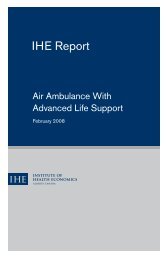Bariatric treatments for adult obesity - Institute of Health Economics
Bariatric treatments for adult obesity - Institute of Health Economics
Bariatric treatments for adult obesity - Institute of Health Economics
- No tags were found...
You also want an ePaper? Increase the reach of your titles
YUMPU automatically turns print PDFs into web optimized ePapers that Google loves.
the action <strong>of</strong> insulin. The two main types <strong>of</strong> diabetes correspond to these two mechanisms and arecalled type 1 diabetes and type 2 diabetes.Diet: what a person eats and drinks, or any type <strong>of</strong> eating plan.Digestive system: includes the organs (that is: salivary glands, mouth, esophagus, stomach, smallintestine, liver, gallbladder, pancreas, colon, rectum, and anus) that are responsible <strong>for</strong> getting foodinto and out <strong>of</strong> the body and <strong>for</strong> making use <strong>of</strong> it.Dumping syndrome: an adverse event caused by eating refined sugar, symptoms <strong>of</strong> which includerapid heart rate, nausea, tremor, faintness, and diarrhea.Endocrinology: the study <strong>of</strong> hormones, their receptors, the intracellular signaling pathways theyinvoke, and the diseases and conditions associated with them.Epidemic: a sudden severe outbreak <strong>of</strong> a disease (the occurrence <strong>of</strong> more cases <strong>of</strong> a disease thanwould be expected in a community or region during a given time period).Excess weight: the difference between one’s actual weight and a healthy weight.Excess weight loss (EWL): surplus weight loss achieved through diet or through medical orsurgical treatment. EWL is measured by weight units (pounds or kilograms) or by a percentage(initial weight – current weight)/(initial weight – ideal weight).Fat: a building block <strong>of</strong> human bodies and a major source <strong>of</strong> energy in the diet. Fat helps the humanbody absorb fat-soluble vitamins (such as vitamins A, D, E, and K) and carotenoids. Fats that are infood/diet are combinations <strong>of</strong> monounsaturated, polyunsaturated, and saturated fatty acids. Alldietary fats contain nine calories per gram, more than twice the number provided by carbohydratesor protein.Gastrointestinal: a term that describes the entire digestive tract, referring collectively to thestomach and the small and large intestines.Gastrointestinal tract: the tube that extends from the mouth to the anus, in which food is digestedthrough the movement <strong>of</strong> muscles and the release <strong>of</strong> hormones and enzymes. It is also called thealimentary canal, the digestive tract, and the GI tract.Genes: the basic biological units <strong>of</strong> heredity.Genetic: pertaining to inherited characteristics.Glucose: the simple sugar (monosaccharide) that serves as the main source <strong>of</strong> energy in the body.The body makes glucose from proteins, fats, and, in largest part, carbohydrates. Glucose is carried toeach cell through the bloodstream. Cells cannot use glucose without the help <strong>of</strong> insulin. Glucose isalso known as dextrose.Glycemic Index (GI): an index that ranks foods based on their effect on blood sugar in the humanbody. Each food on the Glycemic Index receives a "score" according to how much the blood sugarlevel increases within a few hours <strong>of</strong> eating that food.Gout: a condition characterized by abnormally elevated levels <strong>of</strong> uric acid in the blood, recurringattacks <strong>of</strong> joint inflammation (arthritis), deposits <strong>of</strong> hard lumps <strong>of</strong> uric acid in and around the joints,decreased kidney function, and kidney stones. Uric acid is a breakdown product <strong>of</strong> purines, whichare found in many foods we eat.<strong>Bariatric</strong> <strong>treatments</strong> <strong>for</strong> <strong>adult</strong> <strong>obesity</strong> – March 2012xviii


